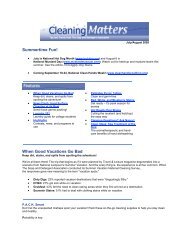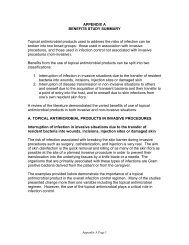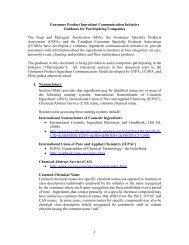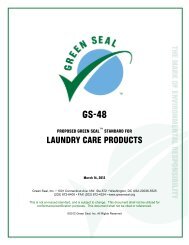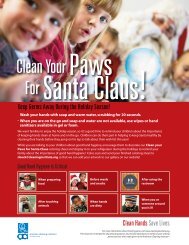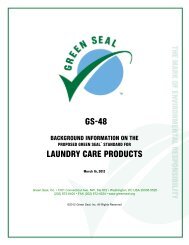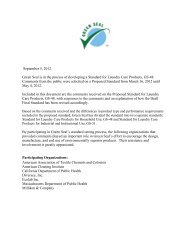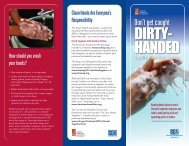subchapter c -- federal hazardous substances act regulations
subchapter c -- federal hazardous substances act regulations
subchapter c -- federal hazardous substances act regulations
Create successful ePaper yourself
Turn your PDF publications into a flip-book with our unique Google optimized e-Paper software.
free, as specified by paragraphs 1.2 and 3.1.4<br />
of Interim Amendment-1(YD), dated<br />
November 14, 1979, to the Federal<br />
Specification entitled Tile, Floor: Asphalt,<br />
Rubber, Vinyl, Vinyl-Asbestos, SS-T-312B,<br />
dated October 10, 1974,1 over at least a 2.5-<br />
inch (6.4-centimeter) thickness of concrete.<br />
The imp<strong>act</strong> area shall be at least 3 square feet<br />
(0.3 square meter). The Commission<br />
recognizes that this specified imp<strong>act</strong> medium<br />
is the equivalent of, and will yield the same<br />
imp<strong>act</strong> test results as, a surface covered with<br />
vinyl-asbestos tile meeting the requirements of<br />
Federal Specification SS-T-312A.<br />
(3) Testing procedure. except as provided<br />
in paragraph (b)(4) (i) and (ii) of this section,<br />
the toy shall be dropped four times from a<br />
height of 3 feet ±0.5 inch (0.92 meter) onto the<br />
imp<strong>act</strong> medium described in paragraph (b)(2)<br />
of this section. The toy shall be dropped in<br />
random orientation. After each drop, the test<br />
sample shall be allowed to come to rest and<br />
shall be examined and evaluated before<br />
continuing.<br />
(4) Large and bulky toys. (i) A toy that has<br />
a projected base area of 400 or more square<br />
inches (2,560 or more square centimeters)<br />
shall be tested for imp<strong>act</strong> in accordance with<br />
paragraph (b)(4)(iii) of this subsection. The<br />
base area for toys having permanently attached<br />
legs shall be measured by calculating the area<br />
enclosed by straight lines connecting the<br />
outermost edge of each leg of the perimeter.<br />
(ii) A toy that has a volume of more than 3<br />
cubic feet (0.085 cubic meter), calculated by<br />
the major dimensions without regard to minor<br />
appendages, shall be tested for imp<strong>act</strong> in<br />
accordance with paragraph (b)(4)(iii) of this<br />
section.<br />
(iii) The toys described in paragraph (b)(4)<br />
(i) and (ii) of this section shall be tested for<br />
imp<strong>act</strong> by tipping them over three times by<br />
pushing the samples slowly past their centers<br />
of balance onto the imp<strong>act</strong> medium described<br />
in paragraph (b)(2) of this section.<br />
(c) Bite test — (1) Application. A toy (or<br />
component) that is a mouth toy shall be<br />
subject to this test.<br />
(2) Test equipment — (i) Cont<strong>act</strong><br />
mechanism. The cont<strong>act</strong> mechanism shall be<br />
two metal strips or plates each measuring 0.25<br />
inch ±0.002 inch (0.635 centimeter) high and<br />
each having a cont<strong>act</strong> edge radius of 0.020<br />
inch ±0.002 inch (0.5 centimeter) for at least a<br />
16 CFR Ch. II (1–1–05 Edition)—proposed modificication – 6/25/06<br />
-- 63 --<br />
150-degree cross-sectional arc. A suggested<br />
cont<strong>act</strong> mechanism appears in figure 1 of §<br />
1500.51.<br />
(ii) Loading device. The loading device<br />
shall be a scale or force gauge having an<br />
accuracy of ±0.5 pound (±225 grams).<br />
(3) Testing procedure. The test article shall<br />
be placed in the cont<strong>act</strong> mechanism in any<br />
reasonable position for a penetration of 0.25 to<br />
0.5 inch (0.64 to 1.27 centimeters), which<br />
position utilizes less than 180 degrees of the<br />
arc of the contr<strong>act</strong> mechanism, and a test load<br />
increasing to 100 pounds ±0.5 pound (45.50<br />
kilograms) shall be evenly applied within 5<br />
seconds. This load shall be maintained for an<br />
additional 10 seconds.<br />
(d) Flexure test—(1) Application. This test<br />
shall be applied to each component of a toy<br />
containing metal wire(s), or other metal<br />
material(s), for stiffening or for retention of<br />
form if the component can be bent through a<br />
60-degree arc by a maximum force of 15<br />
pounds ±0.5 pound (6.80 kilograms) applied<br />
perpendicularly to the major axis of the<br />
component at a point 2 inches ±0.05 inch (5<br />
centimeters) from the intersection of the<br />
component with the main body of the toy or at<br />
the end of the component if the component is<br />
less than 2 inches ±0.05 inch (5 centimeters)<br />
long.<br />
(2) Testing procedure. The toy shall be<br />
secured in a vise equipped with vise shields<br />
that are fabricated from 13-gauge cold-rolled<br />
steel or other similar material and that have a<br />
0.375-inch (0.95-centimeter) inside radius.<br />
The component shall then be bent through a<br />
60-degree arc by a force applied at a point on<br />
the component 2 inches (5 centimeters) from<br />
the intersection of the component with the<br />
main body of the toy or applied at the end of<br />
the component if the component is less than 2<br />
inches (5 centimeters) long. The component<br />
shall then be bent in the reverse direction<br />
through a 120-degree arc. This process shall<br />
be repeated for 30 cycles at a rate of one cycle<br />
per two seconds with a 60-second rest period<br />
occurring after each 10 cycles. Two 120-<br />
degree arc bends shall constitute one cycle.<br />
(e) Torque test — (1) Application — (i)<br />
General. A toy with a projection, part, or<br />
assembly that a child can grasp with at least<br />
the thumb and forefinger or the teeth shall be<br />
subject to this test.



